engine overheat Ram ProMaster 2015 Diesel Supplement
[x] Cancel search | Manufacturer: RAM, Model Year: 2015, Model line: ProMaster, Model: Ram ProMaster 2015Pages: 130, PDF Size: 0.59 MB
Page 25 of 130
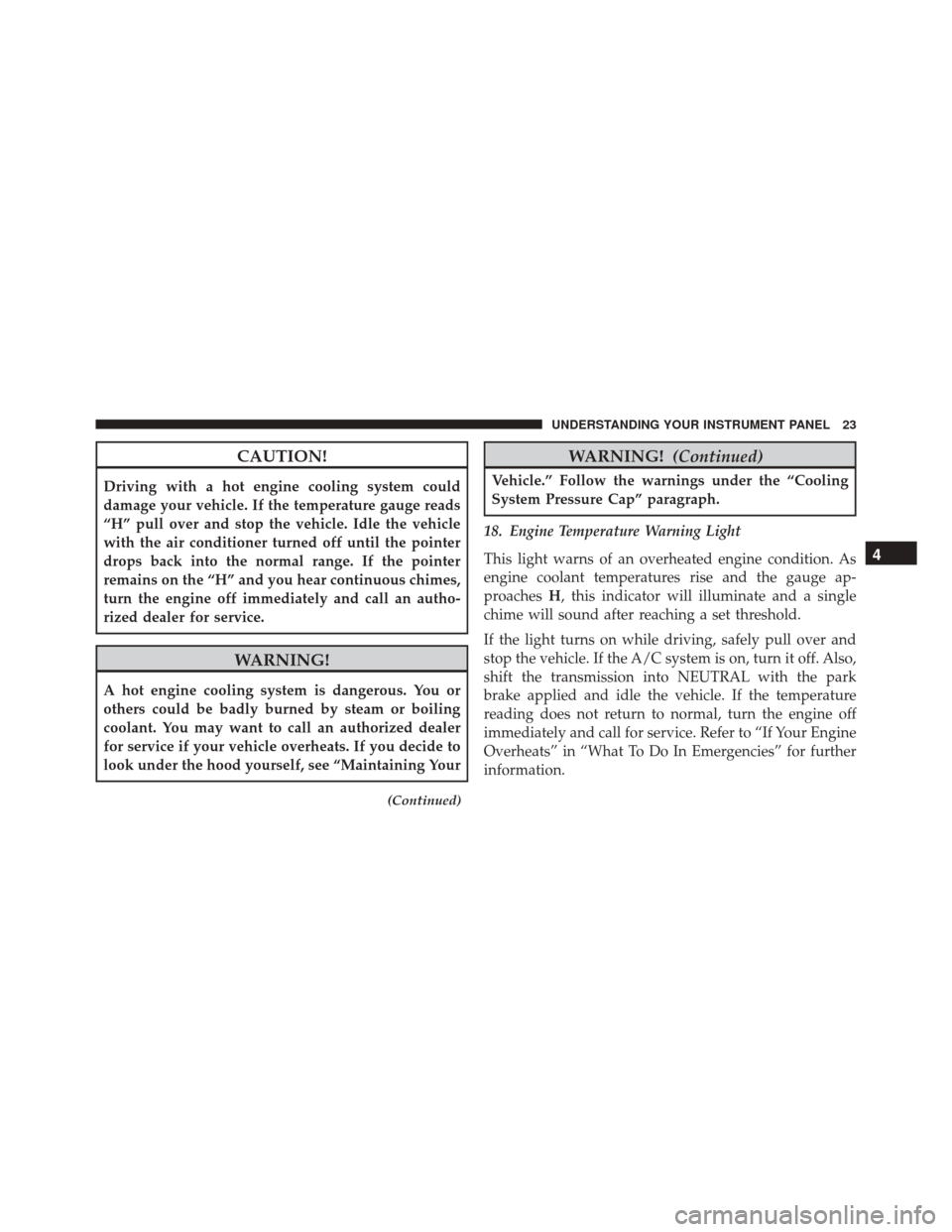
CAUTION!
Driving with a hot engine cooling system could
damage your vehicle. If the temperature gauge reads
“H” pull over and stop the vehicle. Idle the vehicle
with the air conditioner turned off until the pointer
drops back into the normal range. If the pointer
remains on the “H” and you hear continuous chimes,
turn the engine off immediately and call an autho-
rized dealer for service.
WARNING!
A hot engine cooling system is dangerous. You or
others could be badly burned by steam or boiling
coolant. You may want to call an authorized dealer
for service if your vehicle overheats. If you decide to
look under the hood yourself, see “Maintaining Your
(Continued)
WARNING!(Continued)
Vehicle.” Follow the warnings under the “Cooling
System Pressure Cap” paragraph.
18. Engine Temperature Warning Light
This light warns of an overheated engine condition. As
engine coolant temperatures rise and the gauge ap-
proaches H, this indicator will illuminate and a single
chime will sound after reaching a set threshold.
If the light turns on while driving, safely pull over and
stop the vehicle. If the A/C system is on, turn it off. Also,
shift the transmission into NEUTRAL with the park
brake applied and idle the vehicle. If the temperature
reading does not return to normal, turn the engine off
immediately and call for service. Refer to “If Your Engine
Overheats” in “What To Do In Emergencies” for further
information.
4
UNDERSTANDING YOUR INSTRUMENT PANEL 23
Page 39 of 130
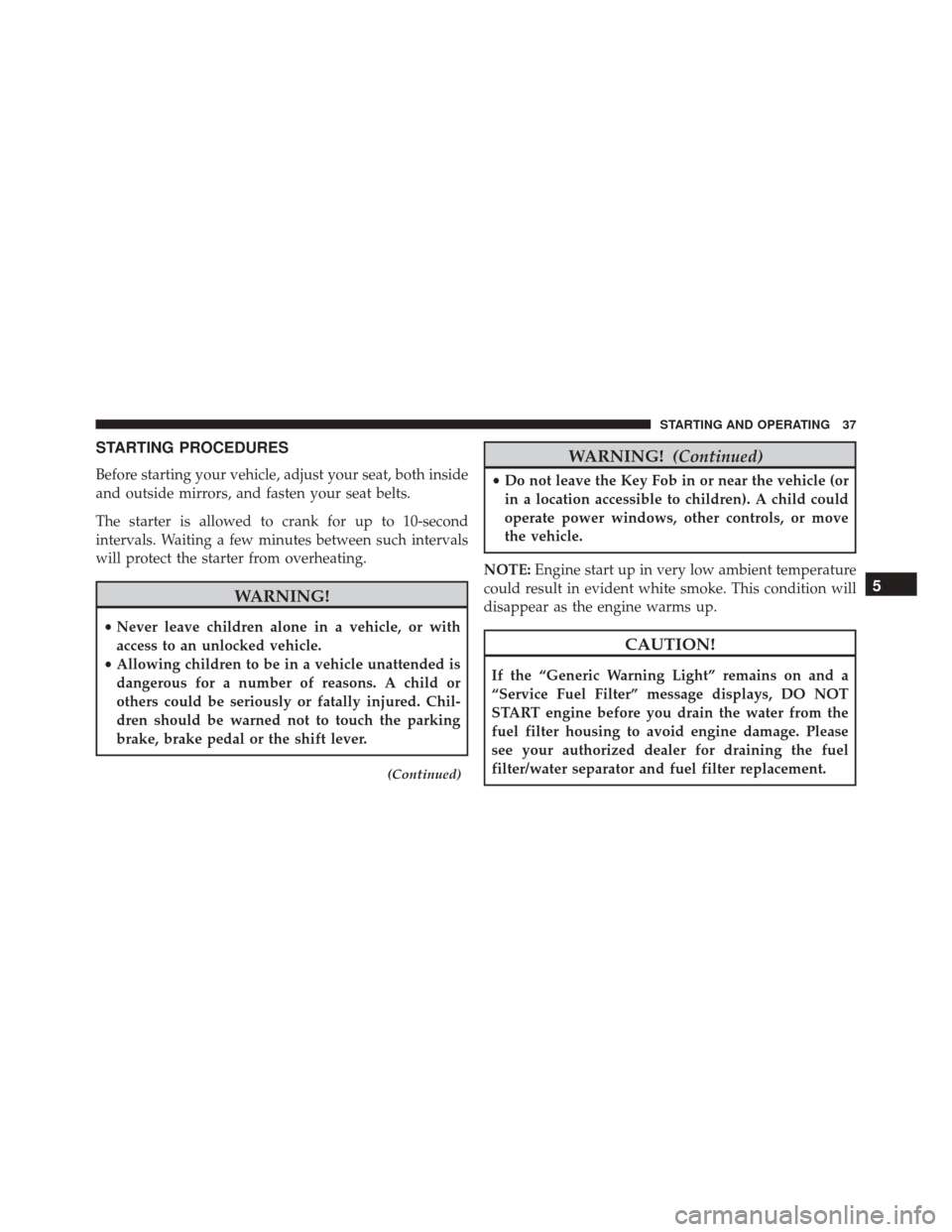
STARTING PROCEDURES
Before starting your vehicle, adjust your seat, both inside
and outside mirrors, and fasten your seat belts.
The starter is allowed to crank for up to 10-second
intervals. Waiting a few minutes between such intervals
will protect the starter from overheating.
WARNING!
•Never leave children alone in a vehicle, or with
access to an unlocked vehicle.
• Allowing children to be in a vehicle unattended is
dangerous for a number of reasons. A child or
others could be seriously or fatally injured. Chil-
dren should be warned not to touch the parking
brake, brake pedal or the shift lever.
(Continued)
WARNING! (Continued)
•Do not leave the Key Fob in or near the vehicle (or
in a location accessible to children). A child could
operate power windows, other controls, or move
the vehicle.
NOTE: Engine start up in very low ambient temperature
could result in evident white smoke. This condition will
disappear as the engine warms up.
CAUTION!
If the “Generic Warning Light” remains on and a
“Service Fuel Filter” message displays, DO NOT
START engine before you drain the water from the
fuel filter housing to avoid engine damage. Please
see your authorized dealer for draining the fuel
filter/water separator and fuel filter replacement.
5
STARTING AND OPERATING 37
Page 55 of 130
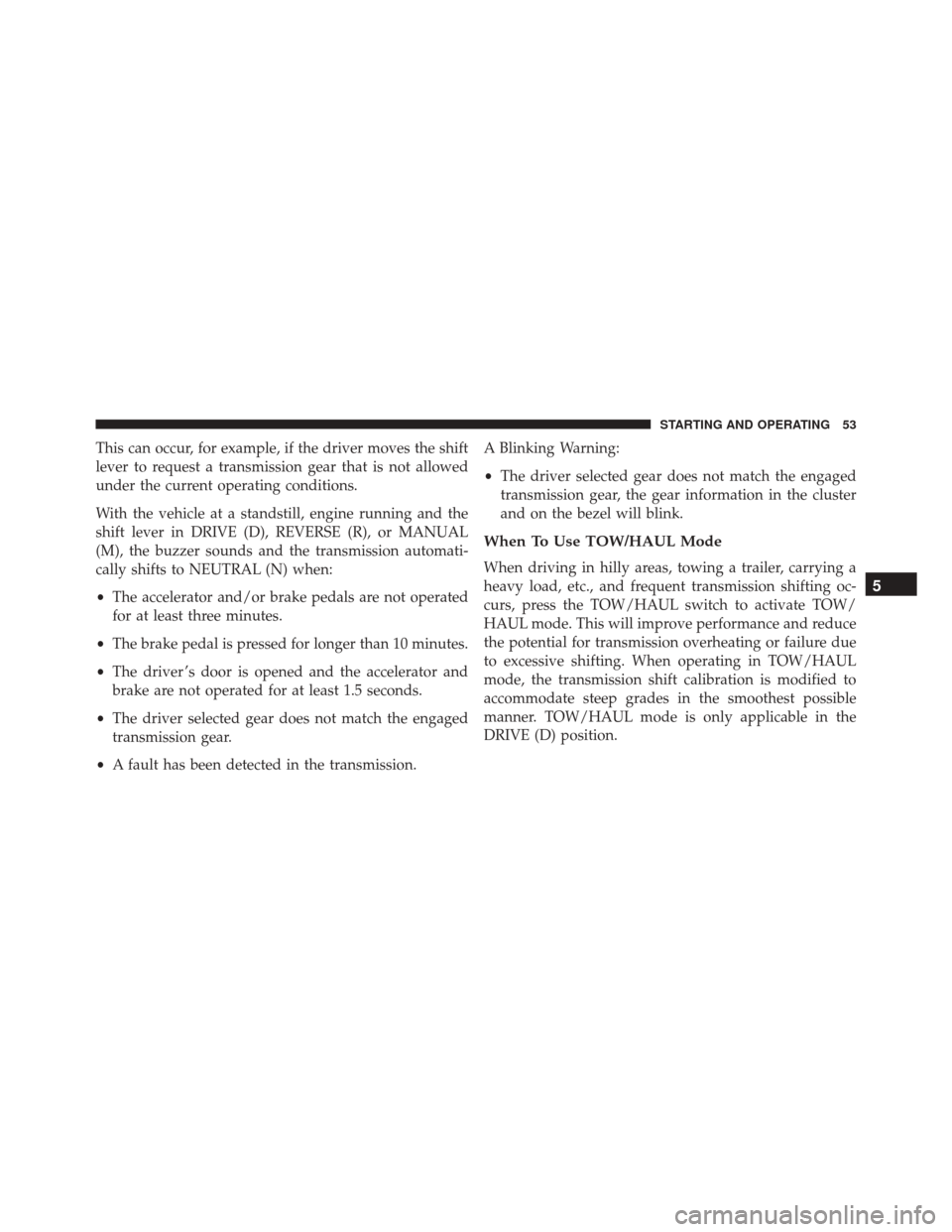
This can occur, for example, if the driver moves the shift
lever to request a transmission gear that is not allowed
under the current operating conditions.
With the vehicle at a standstill, engine running and the
shift lever in DRIVE (D), REVERSE (R), or MANUAL
(M), the buzzer sounds and the transmission automati-
cally shifts to NEUTRAL (N) when:
•The accelerator and/or brake pedals are not operated
for at least three minutes.
• The brake pedal is pressed for longer than 10 minutes.
• The driver ’s door is opened and the accelerator and
brake are not operated for at least 1.5 seconds.
• The driver selected gear does not match the engaged
transmission gear.
• A fault has been detected in the transmission. A Blinking Warning:
•
The driver selected gear does not match the engaged
transmission gear, the gear information in the cluster
and on the bezel will blink.
When To Use TOW/HAUL Mode
When driving in hilly areas, towing a trailer, carrying a
heavy load, etc., and frequent transmission shifting oc-
curs, press the TOW/HAUL switch to activate TOW/
HAUL mode. This will improve performance and reduce
the potential for transmission overheating or failure due
to excessive shifting. When operating in TOW/HAUL
mode, the transmission shift calibration is modified to
accommodate steep grades in the smoothest possible
manner. TOW/HAUL mode is only applicable in the
DRIVE (D) position.
5
STARTING AND OPERATING 53
Page 57 of 130
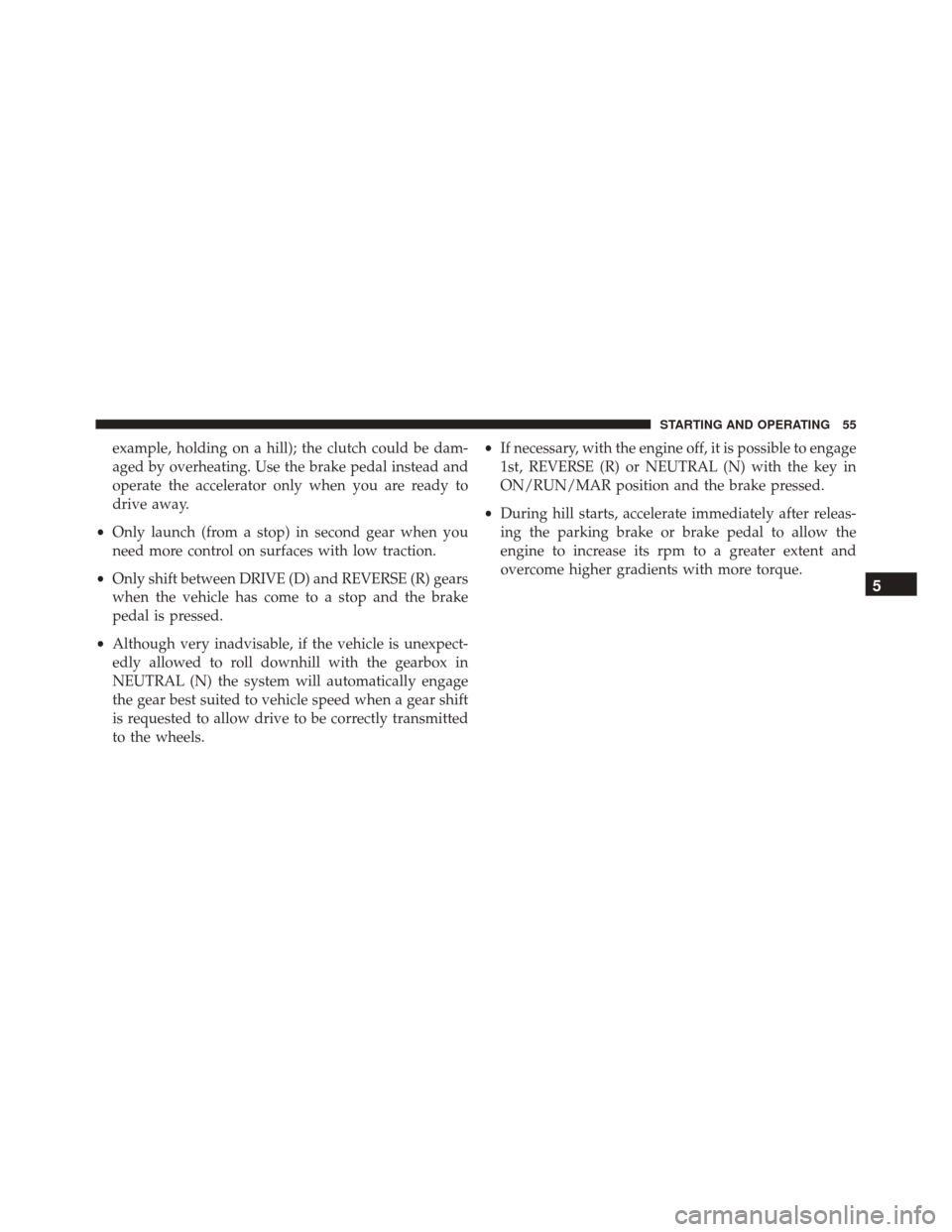
example, holding on a hill); the clutch could be dam-
aged by overheating. Use the brake pedal instead and
operate the accelerator only when you are ready to
drive away.
• Only launch (from a stop) in second gear when you
need more control on surfaces with low traction.
• Only shift between DRIVE (D) and REVERSE (R) gears
when the vehicle has come to a stop and the brake
pedal is pressed.
• Although very inadvisable, if the vehicle is unexpect-
edly allowed to roll downhill with the gearbox in
NEUTRAL (N) the system will automatically engage
the gear best suited to vehicle speed when a gear shift
is requested to allow drive to be correctly transmitted
to the wheels. •
If necessary, with the engine off, it is possible to engage
1st, REVERSE (R) or NEUTRAL (N) with the key in
ON/RUN/MAR position and the brake pressed.
• During hill starts, accelerate immediately after releas-
ing the parking brake or brake pedal to allow the
engine to increase its rpm to a greater extent and
overcome higher gradients with more torque.
5
STARTING AND OPERATING 55
Page 59 of 130
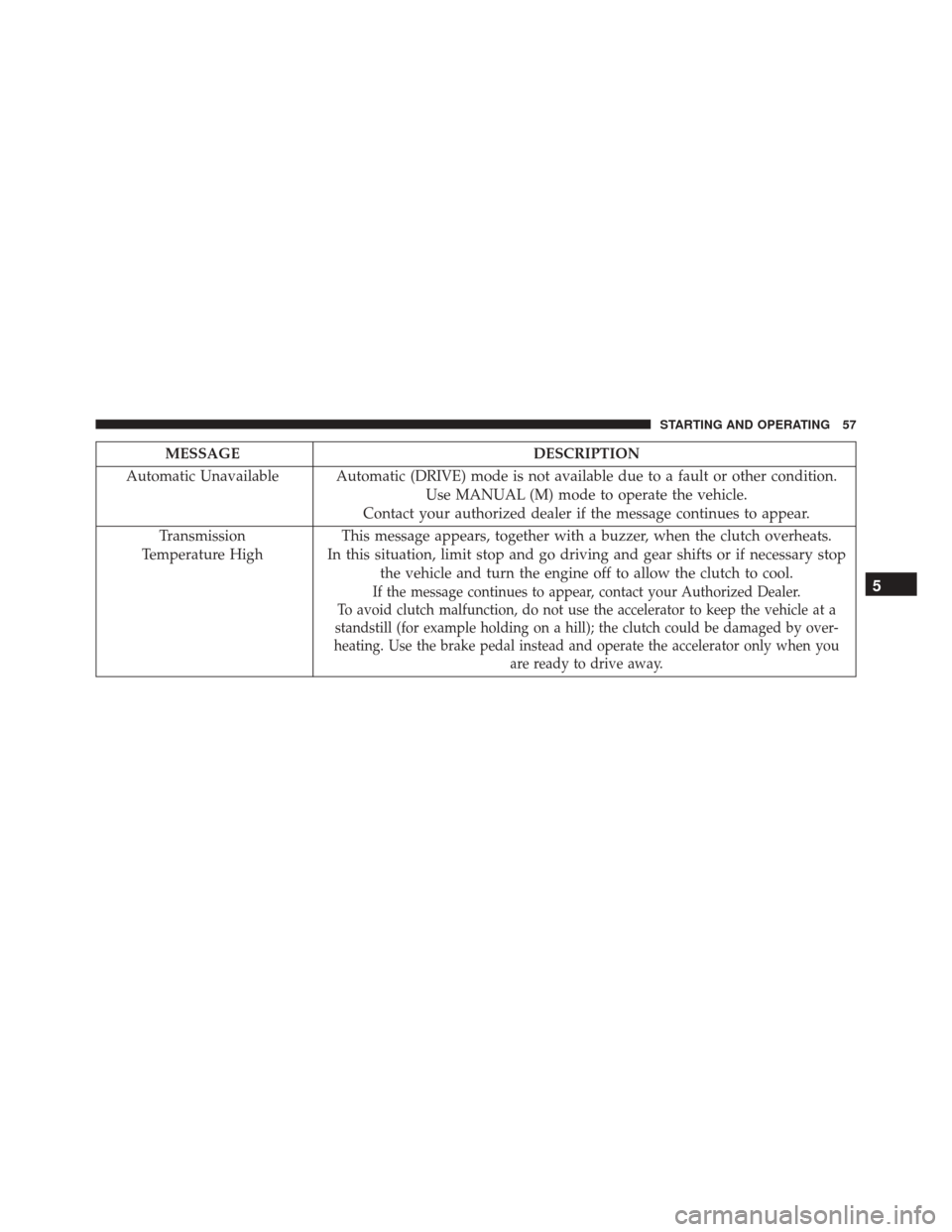
MESSAGEDESCRIPTION
Automatic Unavailable Automatic (DRIVE) mode is not available due to a fault or other condition. Use MANUAL (M) mode to operate the vehicle.
Contact your authorized dealer if the message continues to appear.
Transmission
Temperature High This message appears, together with a buzzer, when the clutch overheats.
In this situation, limit stop and go driving and gear shifts or if necessary stop the vehicle and turn the engine off to allow the clutch to cool.
If the message continues to appear, contact your Authorized Dealer.
To avoid clutch malfunction, do not use the accelerator to keep the vehicle at a
standstill (for example holding on a hill); the clutch could be damaged by over-
heating. Use the brake pedal instead and operate the accelerator only when you are ready to drive away.5
STARTING AND OPERATING 57
Page 86 of 130
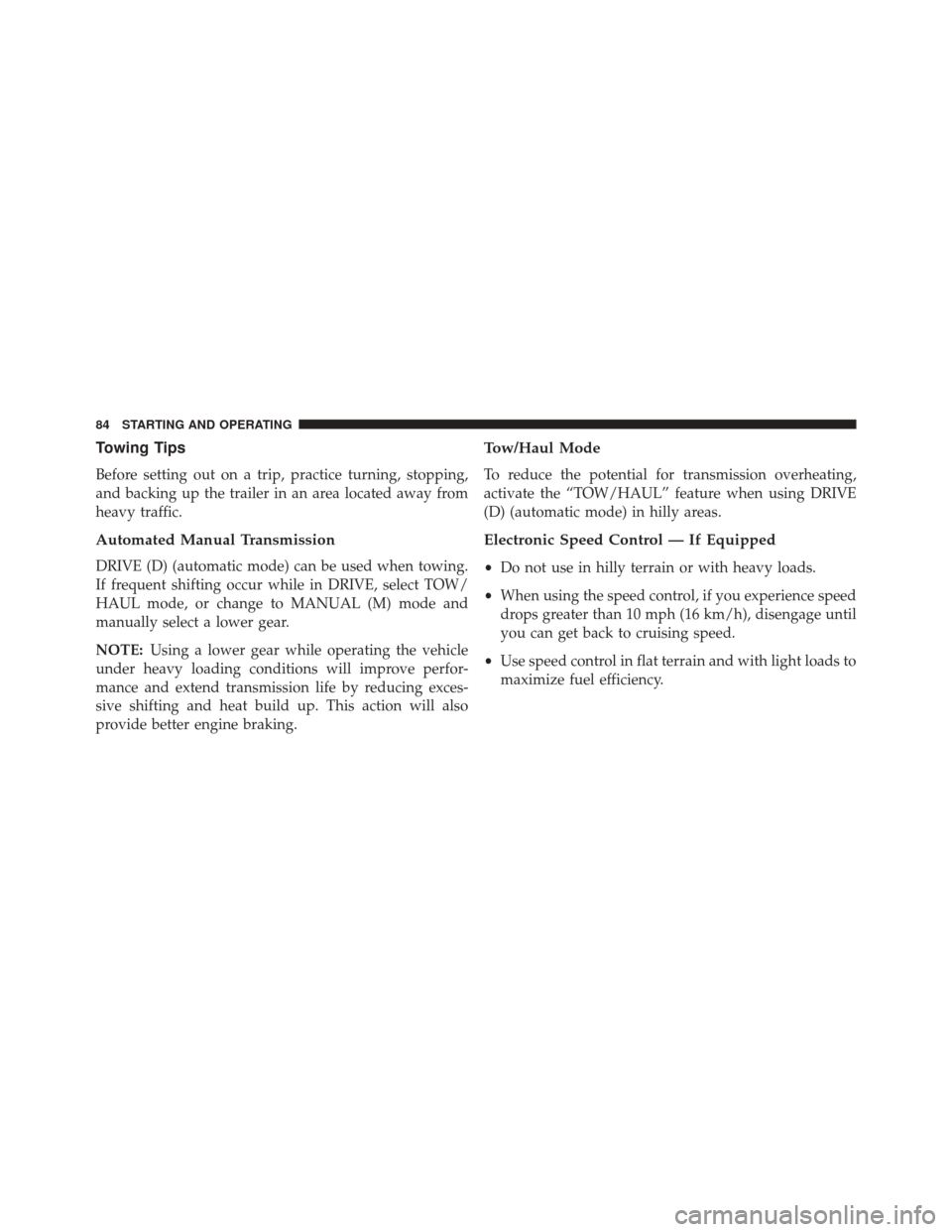
Towing Tips
Before setting out on a trip, practice turning, stopping,
and backing up the trailer in an area located away from
heavy traffic.
Automated Manual Transmission
DRIVE (D) (automatic mode) can be used when towing.
If frequent shifting occur while in DRIVE, select TOW/
HAUL mode, or change to MANUAL (M) mode and
manually select a lower gear.
NOTE:Using a lower gear while operating the vehicle
under heavy loading conditions will improve perfor-
mance and extend transmission life by reducing exces-
sive shifting and heat build up. This action will also
provide better engine braking.
Tow/Haul Mode
To reduce the potential for transmission overheating,
activate the “TOW/HAUL” feature when using DRIVE
(D) (automatic mode) in hilly areas.
Electronic Speed Control — If Equipped
• Do not use in hilly terrain or with heavy loads.
• When using the speed control, if you experience speed
drops greater than 10 mph (16 km/h), disengage until
you can get back to cruising speed.
• Use speed control in flat terrain and with light loads to
maximize fuel efficiency.
84 STARTING AND OPERATING
Page 103 of 130
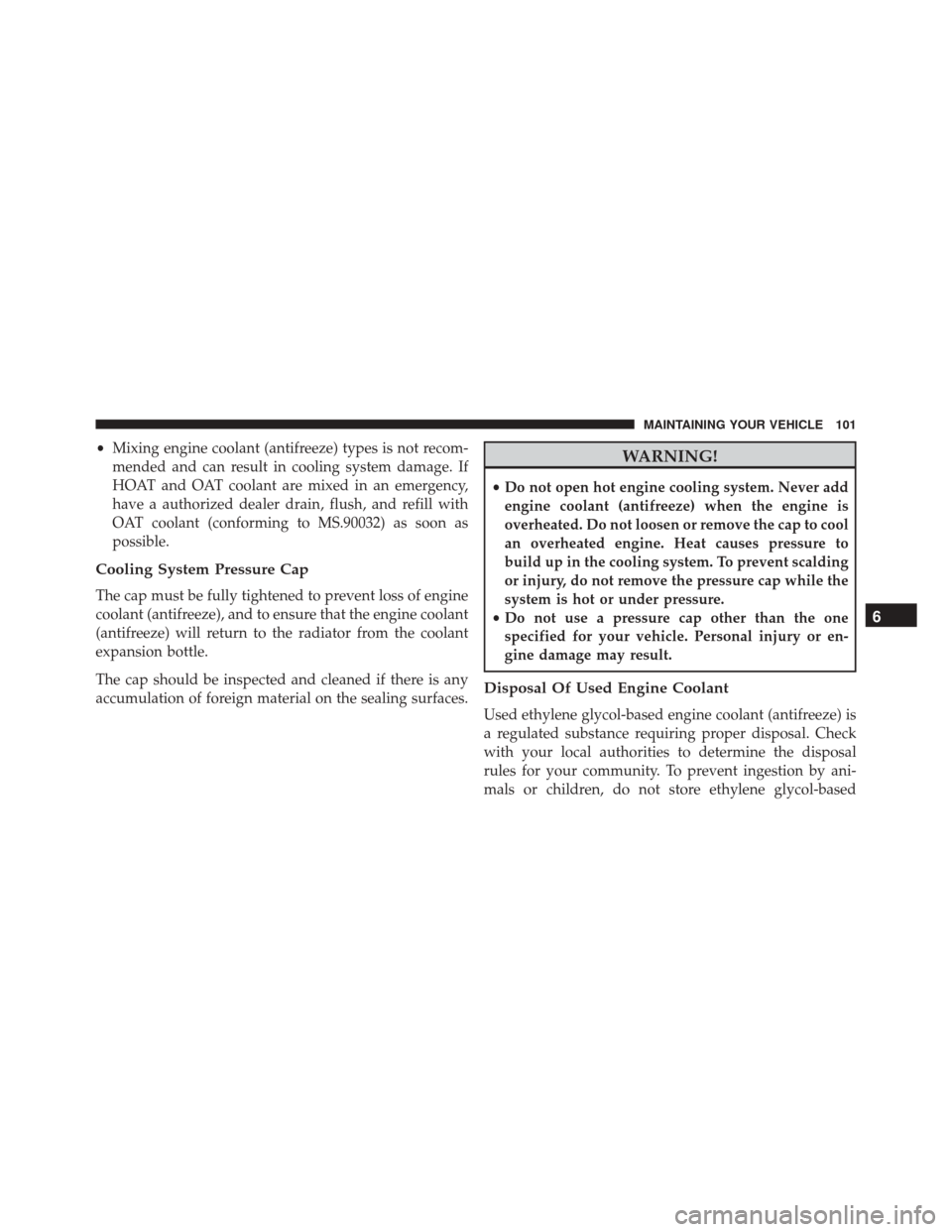
•Mixing engine coolant (antifreeze) types is not recom-
mended and can result in cooling system damage. If
HOAT and OAT coolant are mixed in an emergency,
have a authorized dealer drain, flush, and refill with
OAT coolant (conforming to MS.90032) as soon as
possible.
Cooling System Pressure Cap
The cap must be fully tightened to prevent loss of engine
coolant (antifreeze), and to ensure that the engine coolant
(antifreeze) will return to the radiator from the coolant
expansion bottle.
The cap should be inspected and cleaned if there is any
accumulation of foreign material on the sealing surfaces.
WARNING!
• Do not open hot engine cooling system. Never add
engine coolant (antifreeze) when the engine is
overheated. Do not loosen or remove the cap to cool
an overheated engine. Heat causes pressure to
build up in the cooling system. To prevent scalding
or injury, do not remove the pressure cap while the
system is hot or under pressure.
• Do not use a pressure cap other than the one
specified for your vehicle. Personal injury or en-
gine damage may result.
Disposal Of Used Engine Coolant
Used ethylene glycol-based engine coolant (antifreeze) is
a regulated substance requiring proper disposal. Check
with your local authorities to determine the disposal
rules for your community. To prevent ingestion by ani-
mals or children, do not store ethylene glycol-based
6
MAINTAINING YOUR VEHICLE 101